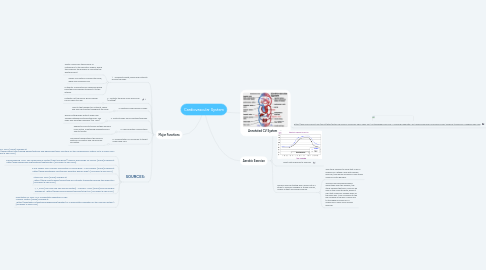
1. Major Functions
1.1. 1. Transports waste, gases and nutrients around the body
1.1.1. Waste: Goes from the process of metabolism to the excretory organs, which then preform the process of removing the waste product
1.1.2. Gases: Circulates O2 around the body, while also removing CO2
1.1.3. Nutrients: Transported via capillaries which have the blood vessels transport it to the arteries
1.2. 2. Protects the body from blood loss (Clotting)
1.2.1. Platelets clot the blood. Blood change from a liquid to a gel.
1.3. 3. Maintains fluid balance in body
1.3.1. Links to the transport of nutrients, gases and also electrolytes throughout the body
1.4. 4. Protects body from infections/diseases
1.4.1. Blood clotting helps protect body from foreign pathogens entering the body. The body also has other defenses (e.g. Liver)
1.5. 5. Helps maintain Homeostasis
1.5.1. Redirects blood to tissues as they become more active, maintaining adequate blood flow to tissues
1.6. 6. Transportation of Hormones to target organs and cells
1.6.1. Hormones transported in the blood in systemic circulation and a pulmonary circulation.
1.7. SOURCES:
1.7.1. PT DIRECT. 2020. [online] Available at: <https://www.ptdirect.com/training-design/anatomy-and-physiology/major-functions-of-the-cardiovascular-system-2013-a-closer-look> [Accessed 19 April 2020].
1.7.2. Cancerindex.org. 2020. The Cardiovascular System (Heart And Blood) | Medical Terminology For Cancer. [online] Available at: <http://www.cancerindex.org/medterm/medtm8.htm> [Accessed 19 April 2020].
1.7.3. A Plus Topper. 2020. Process Of Excretion In Human Body - A Plus Topper. [online] Available at: <https://www.aplustopper.com/process-excretion-human-body/> [Accessed 19 April 2020].
1.7.4. Study.com. 2020. [online] Available at: <https://study.com/academy/lesson/how-are-nutrients-transported-around-the-body.html> [Accessed 19 April 2020].
1.7.5. L, J., 2020. [The Liver And The Immune System]. - Pubmed - NCBI. [online] Ncbi.nlm.nih.gov. Available at: <https://www.ncbi.nlm.nih.gov/pubmed/26186144> [Accessed 19 April 2020].
1.7.6. Opentextbc.ca. 2020. 20.4 Homeostatic Regulation Of The Vascular System. [online] Available at: <https://opentextbc.ca/anatomyandphysiology/chapter/20-4-homeostatic-regulation-of-the-vascular-system/> [Accessed 19 April 2020].
2. Annotated CV System
3. Aerobic Exercise
3.1. Sources
3.1.1. https://web.a.ebscohost.com/ehost/detail/detail?vid=8&sid=334dfc6a-e8ff-4d8b-a971-871eedebbb34%40sdc-v-sessmgr03&bdata=JkF1dGhUeXBlPWlwLHNoaWImc2l0ZT1laG9zdC1saXZl#AN=9338097&db=a9h
3.2. Heart Rate response to exercise
3.3. Aerobic exercise testing was carried out in a study to measure changes in stroke volume, cardiac output and blood pressure.
3.3.1. This study seemed to show that a rise in maximal O2 uptake came with aerobic exercise, through an increase in max stroke volume in both genders.
3.3.2. The boys do have physiological advantages over the females, the study showed that boys. This can be seen in the collected data, where it says that maximum oxygen levels of the boys was +15% compared to the 8% increase in the girls. Mainly due to the higher increase of SV maximum in males from aerobic exercise.
